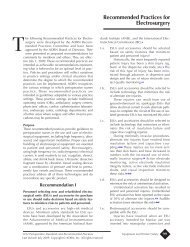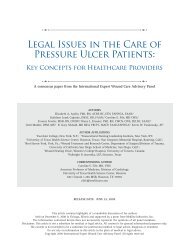2009 CAUTI guidelines - Centers for Disease Control and Prevention
2009 CAUTI guidelines - Centers for Disease Control and Prevention
2009 CAUTI guidelines - Centers for Disease Control and Prevention
Create successful ePaper yourself
Turn your PDF publications into a flip-book with our unique Google optimized e-Paper software.
IV. Recommendations <strong>for</strong> Further ResearchOur literature review revealed that many of the studies addressing strategies to prevent <strong>CAUTI</strong>were not of sufficient quality to allow firm conclusions regarding the benefit of certaininterventions. Future studies of <strong>CAUTI</strong> prevention should:1) Be primary analytic research (i.e. systematic reviews, meta-analyses,interventional studies, <strong>and</strong> observational studies [cohort, case-control, analyticcross-sectional studies])2) Evaluate clinically relevant outcomes (e.g., SUTI, bloodstream infectionssecondary to <strong>CAUTI</strong>)3) Adjust <strong>for</strong> confounders as needed using multivariable analyses4) Stratify outcomes by patient populations at risk <strong>for</strong> <strong>CAUTI</strong>5) Ensure adequate statistical power to detect differencesThe following is a compilation of recommendations <strong>for</strong> further research:1. Catheter materialsa. Antimicrobial <strong>and</strong> antiseptic-impregnated cathetersi. Effect of catheters on reducing the risk of SUTI <strong>and</strong> other clinicallysignificant outcomesii. Patient populations most likely to benefitiii. Incidence of antimicrobial resistance in urinary pathogensiv. Role of bacterial biofilms in the pathogenesis of <strong>CAUTI</strong>b. St<strong>and</strong>ard cathetersi. Optimal materials <strong>for</strong> reducing the risk of <strong>CAUTI</strong> <strong>and</strong> other urethralcomplications2. Appropriate urinary catheter usea. Incontinent patientsi. Risks <strong>and</strong> benefits of periodic (e.g., nighttime) use of external cathetersii. Risk of local complications (e.g., skin maceration, phimosis) with the useof external cathetersiii. Appropriate use of urinary catheters to manage sacral or perineal woundsb. Appropriate indications <strong>for</strong> continued use in postoperative patients <strong>and</strong>associated risks3. Antisepticsa. Use of antiseptic vs. sterile solutions <strong>for</strong> periurethral cleaning prior to catheterinsertionb. Use of antiseptics (e.g., methenamine) to prevent <strong>CAUTI</strong>4. Alternatives to indwelling urethral catheters <strong>and</strong> bag drainagea. Risks <strong>and</strong> benefits of suprapubic catheters as an alternative to chronic indwellingurethral cathetersb. Use of a urethral stent as an alternative to an indwelling catheter in selectedpatients with bladder outlet obstructionc. Use of catheter valves in reducing the risk of <strong>CAUTI</strong> <strong>and</strong> other urinarycomplicationsd. Other alternative methods of urinary drainage20
















